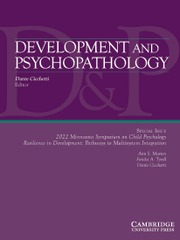Crossref Citations
This article has been cited by the following publications. This list is generated based on data provided by
Crossref.
Séguin, Jean R.
2004.
Neurocognitive elements of antisocial behavior: Relevance of an orbitofrontal cortex account.
Brain and Cognition,
Vol. 55,
Issue. 1,
p.
185.
Liu, Jianghong
Raine, Adrian
Venables, Peter H.
and
Mednick, Sarnoff A.
2004.
Malnutrition at Age 3 Years and Externalizing Behavior Problems at Ages 8, 11, and 17 Years.
American Journal of Psychiatry,
Vol. 161,
Issue. 11,
p.
2005.
Niemi, Laura T.
Suvisaari, Jaana M.
Haukka, Jari K.
and
Lönnqvist, Jouko K.
2005.
Childhood predictors of future psychiatric morbidity in offspring of mothers with psychotic disorder.
British Journal of Psychiatry,
Vol. 186,
Issue. 2,
p.
108.
Raine, Adrian
Moffitt, Terrie E.
Caspi, Avshalom
Loeber, Rolf
Stouthamer-Loeber, Magda
and
Lynam, Don
2005.
Neurocognitive Impairments in Boys on the Life-Course Persistent Antisocial Path..
Journal of Abnormal Psychology,
Vol. 114,
Issue. 1,
p.
38.
OLSON, SHERYL L.
SAMEROFF, ARNOLD J.
KERR, DAVID C. R.
LOPEZ, NESTOR L.
and
WELLMAN, HENRY M.
2005.
Developmental foundations of externalizing problems in young children: The role of effortful control.
Development and Psychopathology,
Vol. 17,
Issue. 01,
Wiedenbauer, Gunnar
and
Jansen-Osmann, Petra
2007.
Mental Rotation Ability of Children with Spina Bifida: What Influence Does Manual Rotation Training Have?.
Developmental Neuropsychology,
Vol. 32,
Issue. 3,
p.
809.
Vaughn, Michael G.
Freedenthal, Stacey
Jenson, Jeffrey M.
and
Howard, Matthew O.
2007.
Psychiatric Symptoms and Substance Use Among Juvenile Offenders.
Criminal Justice and Behavior,
Vol. 34,
Issue. 10,
p.
1296.
Séguin, Jean r.
Sylvers, Patrick
and
Lilienfeld, Scott O.
2007.
The Cambridge Handbook of Violent Behavior and Aggression.
p.
187.
Dodge, Kenneth A.
Coie, John D.
and
Lynam, Donald
2007.
Handbook of Child Psychology.
Enns, Richard A.
Reddon, John R.
Das, J. P.
and
Boukos, Helen
2007.
Measuring Executive Function Deficits in Male Delinquents Using the Cognitive Assessment System.
Journal of Offender Rehabilitation,
Vol. 44,
Issue. 4,
p.
43.
Moffitt, Terrie E.
2007.
The Cambridge Handbook of Violent Behavior and Aggression.
p.
49.
Shaw, Daniel S.
and
Gross, Heather E.
2008.
The Long View of Crime: A Synthesis of Longitudinal Research.
p.
79.
ENNS, RICHARD A.
REDDON, JOHN R.
DAS, J. P.
and
BOUDREAU, ALLISON
2008.
Measuring Executive Functions in Female Delinquents Using the Cognitive Assessment System.
Journal of Offender Rehabilitation,
Vol. 47,
Issue. 1-2,
p.
3.
Foster, Paul S.
Drago, Valeria
Ferguson, Brad J.
and
Harrison, David W.
2008.
Cerebral moderation of cardiovascular functioning: A functional cerebral systems perspective.
Clinical Neurophysiology,
Vol. 119,
Issue. 12,
p.
2846.
Séguin, Jean R.
Parent, Sophie
Tremblay, Richard E.
and
Zelazo, Philip David
2009.
Different neurocognitive functions regulating physical aggression and hyperactivity in early childhood.
Journal of Child Psychology and Psychiatry,
Vol. 50,
Issue. 6,
p.
679.
Dandreaux, Danielle M.
and
Frick, Paul J.
2009.
Developmental Pathways to Conduct Problems: A Further Test of the Childhood and Adolescent-Onset Distinction.
Journal of Abnormal Child Psychology,
Vol. 37,
Issue. 3,
p.
375.
van Domburgh, L.
Loeber, R.
Bezemer, D.
Stallings, R.
and
Stouthamer-Loeber, M.
2009.
Childhood Predictors of Desistance and Level of Persistence in Offending in Early Onset Offenders.
Journal of Abnormal Child Psychology,
Vol. 37,
Issue. 7,
p.
967.
Jiron, Colleen
2009.
Best Practices in School Neuropsychology.
p.
359.
Liu, Jianghong
Raine, Adrian
Wuerker, Anne
Venables, Peter H.
and
Mednick, Sarnoff
2009.
The Association of Birth Complications and Externalizing Behavior in Early Adolescents: Direct and Mediating Effects.
Journal of Research on Adolescence,
Vol. 19,
Issue. 1,
p.
93.
Frick, Paul J.
and
Viding, Essi
2009.
Antisocial behavior from a developmental psychopathology perspective.
Development and Psychopathology,
Vol. 21,
Issue. 4,
p.
1111.

